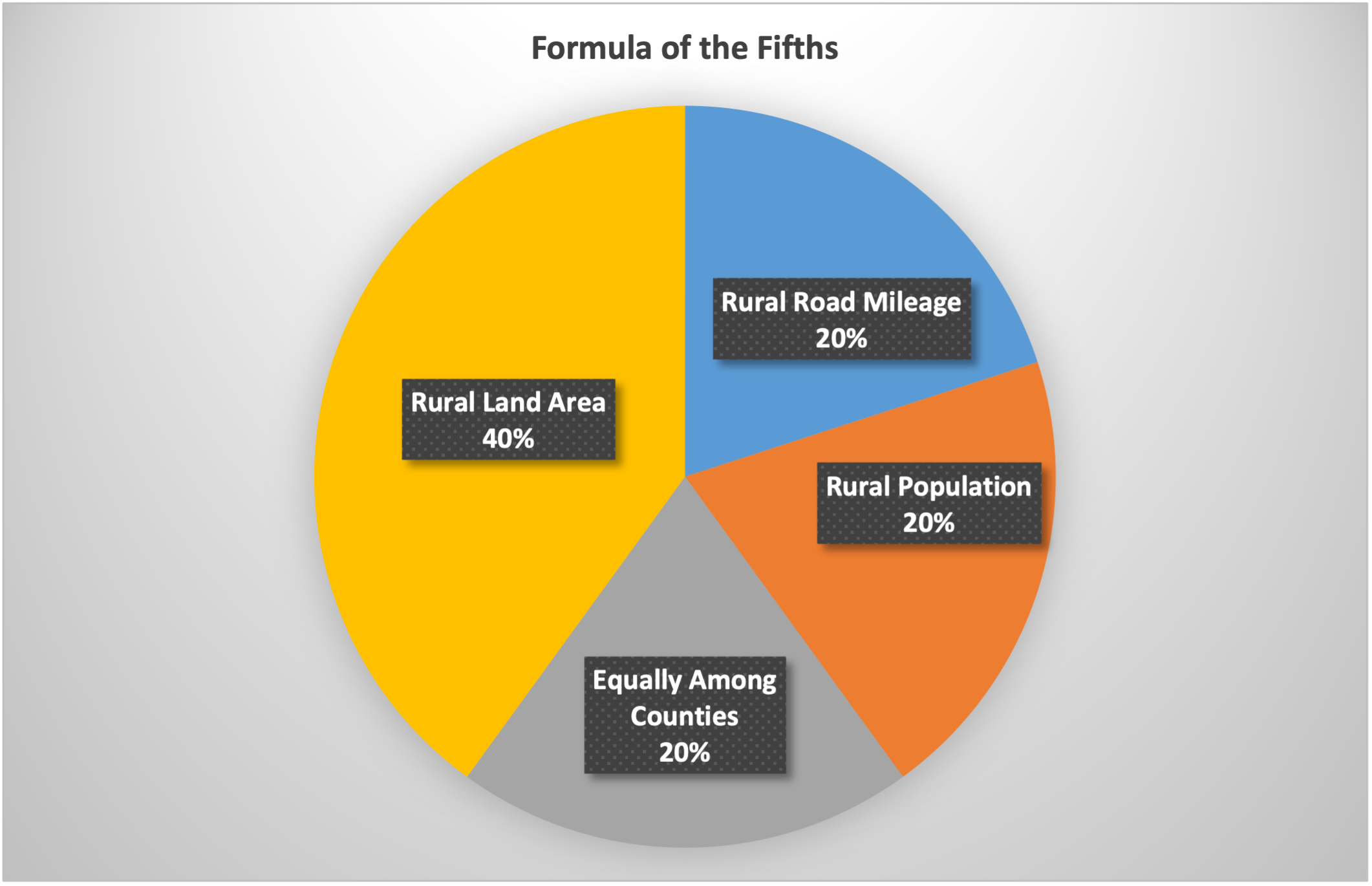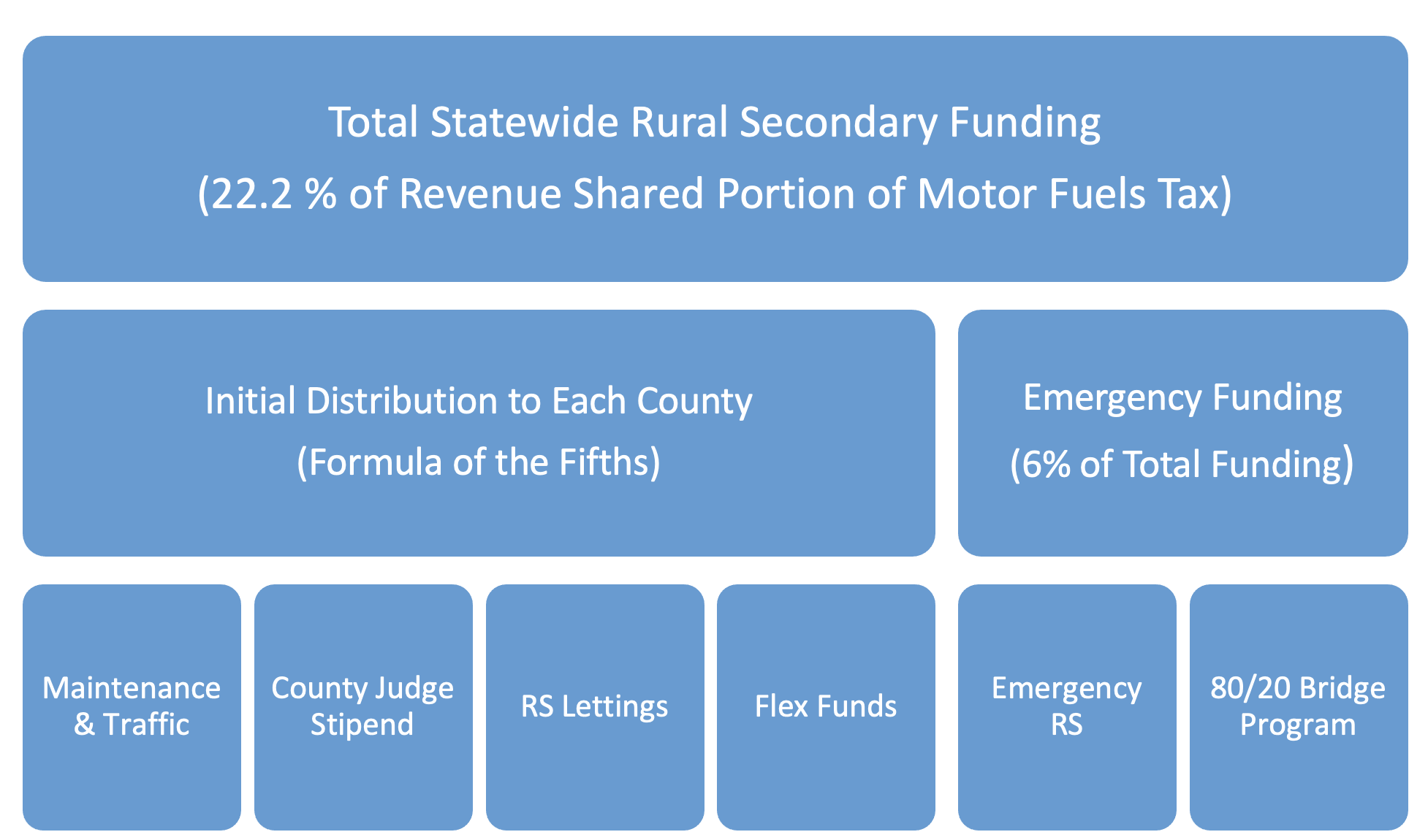Search for articles or browse our knowledge portal by topic.
Department of Rural and Municipal Aid
The Kentucky Transportation Cabinet’s (KYTC) Department of Rural and Municipal Aid serves as the liaison to all local governments on transportation needs. Its offices administer many types of transportation funding that are passed through KYTC to local governments. The Department of Highways (DOH) provides much of the engineering support for Department of Rural and Municipal Aid programs.
The Department of Rural and Municipal Aid is overseen by a commissioner appointed by the Governor. The commissioner’s office oversees a portion of the Discretionary Fund (FD39), also known as the Highway Contingency Account. Funds in this account are used for transportation projects across the state (e.g., resurfacing, bridge replacement, intersection reconstruction) that do not fit within other Cabinet/department programs. Requests for discretionary funding are evaluated at the district level and submitted to the Department of Rural and Municipal Aid for review by the Commissioner, State Highway Engineer, Secretary, and Governor’s office. If approved, discretionary funding requires an MOA with the county fiscal court.
The Department of Rural and Municipal Aid contains two offices: the Office of Rural and Secondary Roads (ORSR), and the Office of Local Programs (OLP).
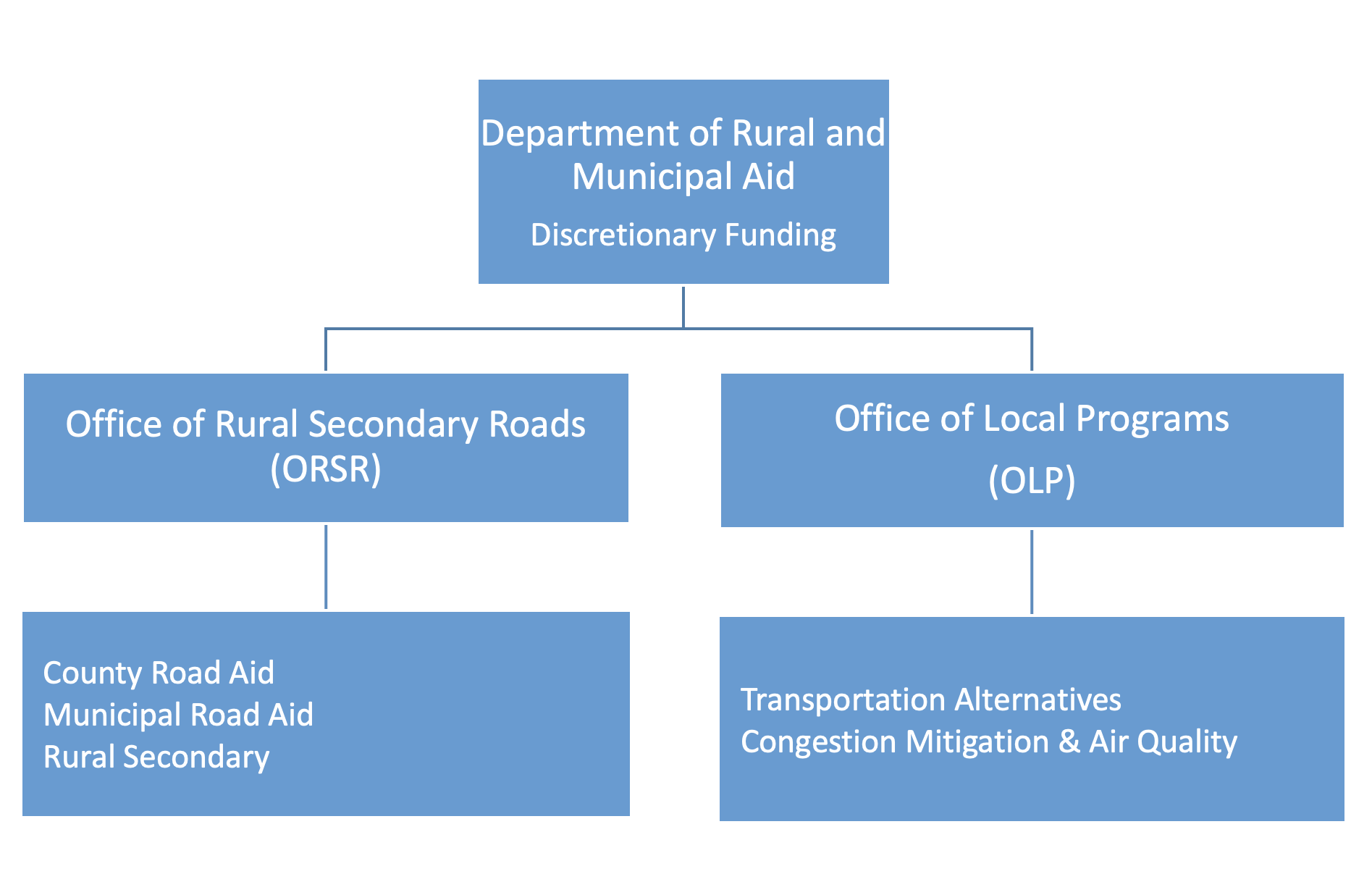
Within the context of ORSR and OLP programs, several key concepts must be kept in mind:
-
- Road Type – Many of the programs are intended for certain road types (e.g., county roads, city streets, rural secondary routes).
- Local Match – Some projects require a local funding match. A typical local match is 20%, which means the project is funded with 20% local funds and 80% state or federal funds.
- Memorandum of Agreement (MOA) – When KYTC allocates funds to an outside entity (e.g., city, county) for a defined project, a MOA is required to specify how the funding will be used.
Within the context of ORSR and OLP programs, several key concepts must be kept in mind:
-
- Road Type – Many of the programs are intended for certain road types (e.g., county roads, city streets, rural secondary routes).
- Local Match – Some projects require a local funding match. A typical local match is 20%, which means the project is funded with 20% local funds and 80% state or federal funds.
- Memorandum of Agreement (MOA) – When KYTC allocates funds to an outside entity (e.g., city, county) for a defined project, a MOA is required to specify how the funding will be used.
1.1 County Road Aid (CRA) and Municipal Road Aid (MRA)
County Road Aid (CRA) Funding
KRS 177.320 stipulates that 18.3% of the revenue-shared portion of Motor Fuels Tax receipts be set aside to fund the CRA Program — 3% of these funds are reserved for emergency use by counties that participate in the cooperative program. Funds are allocated on a case-by-case basis when counties apply for emergency project funding. Remaining CRA funding is used to build, reconstruct, and maintain county roads and is distributed to counties throughout the fiscal year on a predetermined schedule. KYTC uses the formula of the fifths to proportionately distribute these funds to each county based on the five criteria in Figure 1.

Municipal Road Aid (MRA) Funding
KRS 177.365 and KRS 177.366 stipulate that 7.7% of the revenue-shared portion of Motor Fuels Tax receipts is set aside to fund the MRA Program — 3% of these funds are set aside for emergency use by cites that participate in the cooperative program. Funds are allocated on a case-by-case basis when cities apply for emergency project funding. Remaining MRA funding is used to build, reconstruct, and maintain city streets and is distributed to cities throughout the fiscal year on a predetermined schedule.
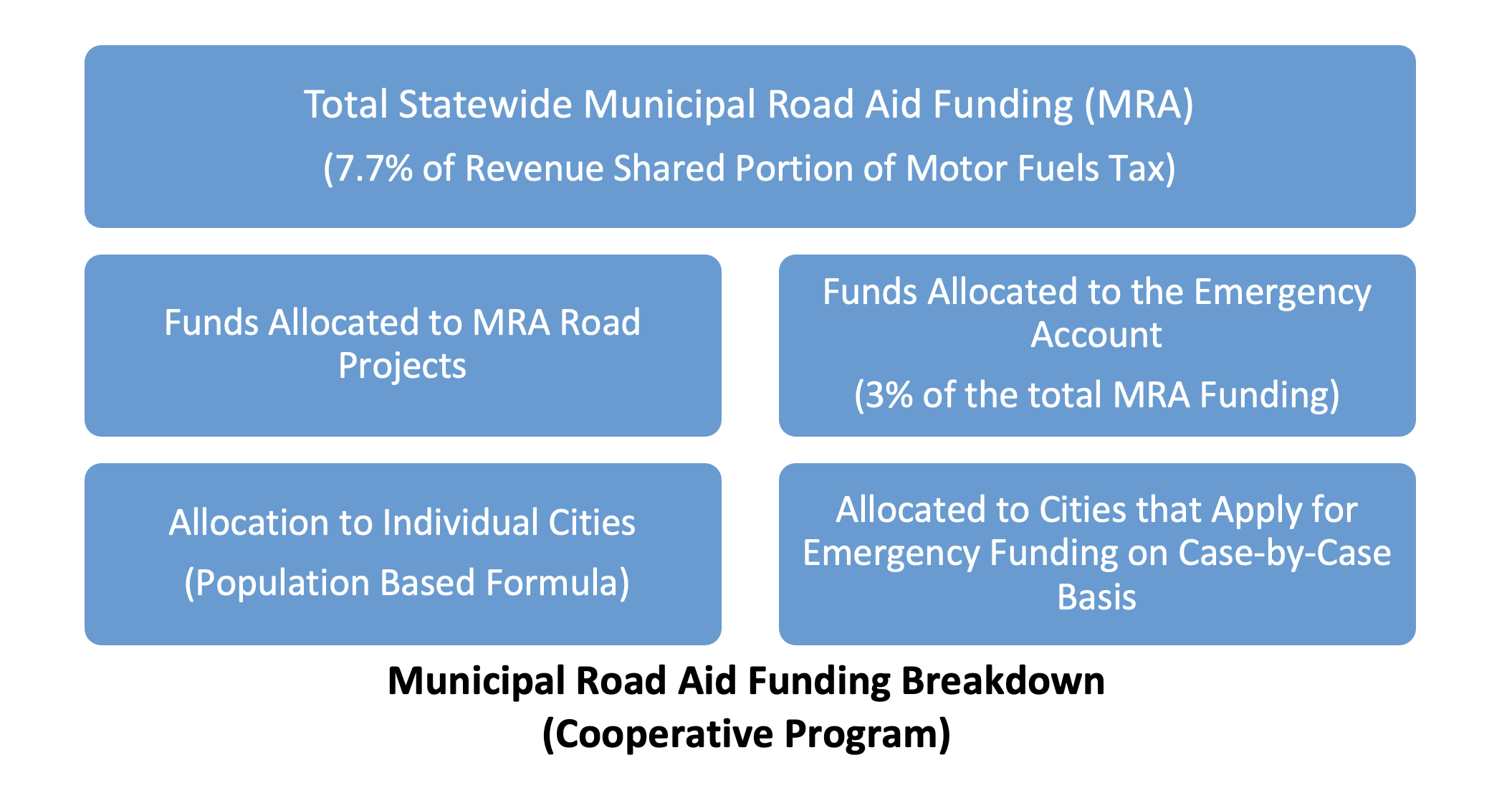
Equation 1 is used to calculate the amount of funding for each city. Population data are taken from the most recent U.S. census.

CRA and MRA Emergency Funds
To request CRA or MRA emergency funding, a county or city must submit to ORSR Form TC 20‐16 (Municipal and County Road Aid Emergency Request), a detailed cost estimate, and pictures of existing site conditions.
For counties and cities, participation in the cooperative program is optional. However, no emergency funding is available for non-participating jurisdictions. Total project funding is allocated based on the formula of the fifths and the Equation 1.

CRA and MRA Program Summary
Table 1 summarizes key features of the CRA and MRA Programs.
| CRA and MRA Program Summary | ||||||
|---|---|---|---|---|---|---|
| Program Code 1 | Program | Recipient\ Project Execution | Road Type | Project Type | Project MOA | Local Match |
| CA01 | CRA | Counties | County Roads | Construction, Reconstruction, Maintenance | No | 0% |
| CA03 | CRA Emergency | Counties | County Roads | Roadway Emergencies | No | 20% |
| CC01 | MRA | Cities | City Streets | Construction, Reconstruction, Maintenance | No | 0% |
| CC03 | MRA Emergency | Cities | City Streets | Roadway Emergencies | No | 20% |
The 4 digit program code for CRA and MRA projects is included in the project number.
1.2 Rural Secondary Program (RS)
Rural Secondary (RS) Funding
KRS 177.320 stipulates that 22.2% of the revenue-shared portion of the Road Fund is set aside for the RS program. Of this, 6% is held back for the RS emergency program and administrative costs. Remaining funds are referred to as the initial distribution and are apportioned to each county using the formula of the fifths. The initial distribution for each county is divided between four sub-programs:
-
- Maintenance and Traffic
- County Judge Stipend
- Flex Funds
- Rural Secondary Lettings

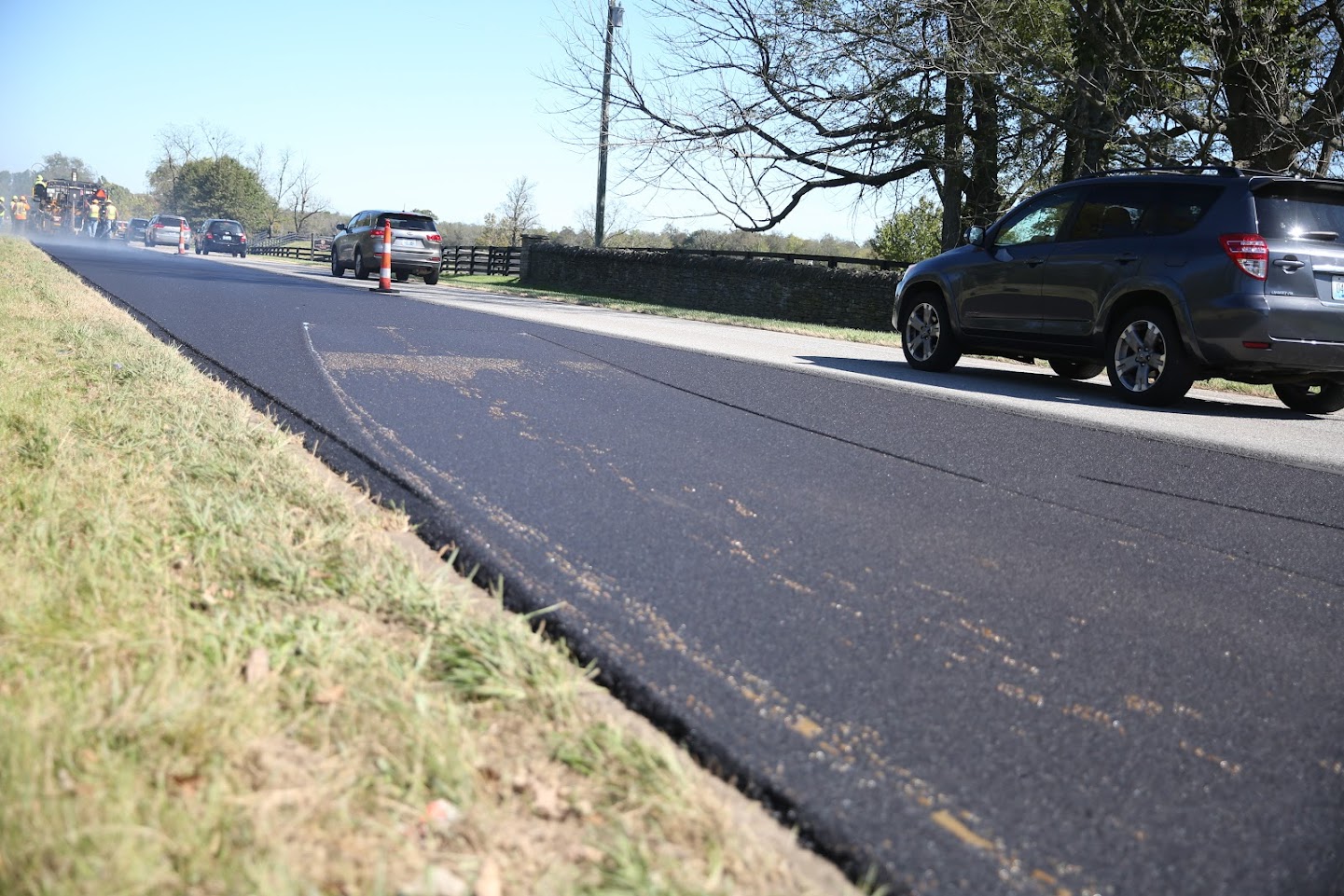
- RS Emergency Funding
- RS emergency funding is used for emergencies on RS routes and the 80/20 Bridge Program. Emergency funds are distributed on a first come first served basis to cities and counties as they apply for projects.
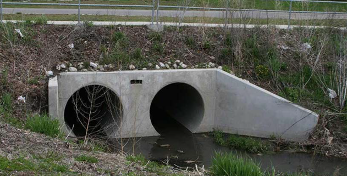
Photo courtesy of Department of Rural and Municipal Aid webpage
Rural Secondary Program Summary
Table 2 summarizes key features of the RS Programs.
Table not viewable on mobile.
| CRA and MRA Program Summary | ||||||
|---|---|---|---|---|---|---|
| Program Code¹ | Program | Recipient\ Project Execution | Road Type | Project Type | Project MOA | Local Match |
| CA01 | Maintenance & Traffic² | District Offices | Rural Secondary | Maintenance: striping, mowing, strip patching, potholes, etc. | No | 0% |
| County Judge Stipend³ | Counties | Any | Any | No | 0% | |
| Flex Funds⁴ | Counties | County Roads | Pavement Repairs & Resurfacing | Yes | 0% | |
| RS Lettings⁵ | District Offices 6 | Rural Secondary | Resurfacing | No | 0% | |
| RS Emergency Funding | ||||||
| CB01 | RS Emergency⁷ | District Offices | Rural Secondary | Roadway Emergencies: road slides, slip repairs, road wash outs, etc. | No | 0% |
| 80/20 Bridge⁸ | Counties | County Roads | Drainage Structures: replacement of bridges, low water fords, cul-verts, pipes, etc | Yes | 20% | |
- The four-digit program code is included in the project number.
- Funding Levels are based on yearly data in the Operating Management System (OMS) administered by the Division of Maintenance and input from the District Offices.
- Currently $2,400 per county judge per year (except Jefferson County).
- Funding levels based on Level of Service (LOS) rankings on RS roads in each county as shown in the Maintenance Rating Program (MRP) administered by the Division of Maintenance.
- Funding Levels = Initial county distribution for the year + Carryover from previous years – Maintenance and traffic allotment – County judge stipend – Flex fund allotment
- Projects go through the typical DOH construction letting process. Construction contracts are administered and inspected by district offices.
- Funding applied for by district offices.
- Funding applied for by counties. Counties can receive up to $80,000 per year.
Red Flag
Approved RS Flex Funds, 80/20 Bridge Program funds, and discretionary funds require a MOA between the county fiscal court and KYTC. No project work should be done until the MOA is fully executed.
OLP administers two federally funded grant programs: the Transportation Alternatives Program (TAP) and the Congestion Mitigation and Air Quality Program (CMAQ). Both programs provide federal funding to local governments — local public agencies (LPA) — for different project types.
OLP also administers the state Scenic Byways and Highways program which designates state and/or local roads as a scenic byway or highway based on one or more archaeological, cultural, historic, natural, recreational or scenic qualities.
The Federal Highway Administration (FHWA) allocates funding and mandates that KYTC provide significant oversight to ensure all relevant state and federal regulations are followed. LPA projects are executed through a combination the LPA, OLP, district offices, and other KTYC Divisions. OLP manages the application cycles during which LPAs can apply for project funding. Both programs:
- Are match-based reimbursement programs that require the LPA to spend its own funds before requesting reimbursement from KTYC.
- Specify a local match of 20% of the project costs; federal funding covers the other 80%.
See the LPA Administration Knowledge Book for more information on administering LPA projects.
ORSR projects and OLP projects differ in two key respects:
- ORSR projects are state funded, whereas most OLP projects are federally funded.
- ORSR projects are maintenance and construction projects, whereas OLP projects involve the entire project development and project delivery processes, which may include planning, design, right of way, utilities and construction. OLP projects cannot fund maintenance activities but will require the LPA to develop a plan for maintenance activities.
2.1 Transportation Alternatives (TAP)
A guardrail impacted by a vehicle laterally deflects in the direction of the crash force. How much it deflects depends on the stiffness of the guardrail system, vehicle speed, angle of impact, and vehicle weight. If a guardrail is to successfully redirect a vehicle, a clear area free of obstructions must be provided between the back of the rail system (e.g., back of posts) and the object or area being shielded. Design deflection distance is the minimum distance between the guardrail and shielded object that should remain clear. It is measured from the back of the guardrail system and is based on MASH crash test results of a pickup truck traveling 62 mph impacting a guardrail at a 25-degree angle. As deflections in the field can be much greater (or lower) depending on impact conditions, treat recommended design deflection distances as minimums. Where practical, provide greater distances between the back of the guardrail system (i.e., back of posts) and the shielded object or area. Carefully examine design deflection distance when deciding where to install guardrail. If a rigid object hazard is
present and the design deflection distance cannot be achieved, either strengthen the guardrail or use a rigid barrier system.
The TAP Program applies federal funds to smaller‐scale transportation projects. Key program characteristics are listed below.
- Eligible work types:
- Pedestrian and bicycle facilities, shared use trails, safe routes to school projects, community improvements (e.g., historic preservation and vegetation management), and environmental mitigation related to stormwater and habitat connectivity.
- TAP projects cannon fund recreation or maintenance activities.
- LPAs apply for projects, receive funds, and are responsible for executing projects.
- A MOA between the LPA and KTYC is required.
- A 20% local match is required.
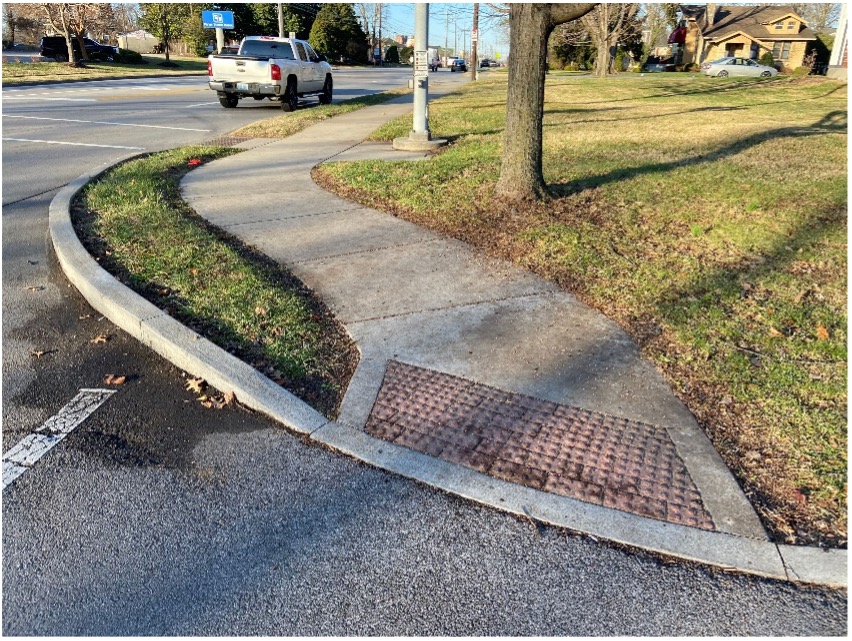
2.2 Congestion Mitigation & Air Quality (CMAQ)
A guardrail impacted by a vehicle laterally deflects in the direction of the crash force. How much it deflects depends on the stiffness of the guardrail system, vehicle speed, angle of impact, and vehicle weight. If a guardrail is to successfully redirect a vehicle, a clear area free of obstructions must be provided between the back of the rail system (e.g., back of posts) and the object or area being shielded. Design deflection distance is the minimum distance between the guardrail and shielded object that should remain clear. It is measured from the back of the guardrail system and is based on MASH crash test results of a pickup truck traveling 62 mph impacting a guardrail at a 25-degree angle. As deflections in the field can be much greater (or lower) depending on impact conditions, treat recommended design deflection distances as minimums. Where practical, provide greater distances between the back of the guardrail system (i.e., back of posts) and the shielded object or area. Carefully examine design deflection distance when deciding where to install guardrail. If a rigid object hazard is
present and the design deflection distance cannot be achieved, either strengthen the guardrail or use a rigid barrier system.
The CMAQ Program focuses on reducing emissions in designated areas of the United States. Key program characteristics are listed below.
Eligible work types:
-
- Projects that significantly improve air quality and decrease traffic congestion
- LPAs apply for projects, receive funds, and are responsible for executing projects.
- A MOA between the LPA and KTYC is required.
- A 20% local match is required.
Federal CMAQ funds must be spent in nonattainment or maintenance areas as determined by the Environmental Protection Agency (EPA). Nonattainment areas are those in which air quality does not meet national standards. Eligible counties include Boone, Boyd, Bullitt, Campbell, Christian, Daviess, Edmonson, Fayette, Jefferson, Kenton, Marshall, Oldham, and Scott. Portions of Greenup, Hancock, Lawrence, and Livingston counties are covered as well.
2.3 Scenic Byways and Highways
A guardrail impacted by a vehicle laterally deflects in the direction of the crash force. How much it deflects depends on the stiffness of the guardrail system, vehicle speed, angle of impact, and vehicle weight. If a guardrail is to successfully redirect a vehicle, a clear area free of obstructions must be provided between the back of the rail system (e.g., back of posts) and the object or area being shielded. Design deflection distance is the minimum distance between the guardrail and shielded object that should remain clear. It is measured from the back of the guardrail system and is based on MASH crash test results of a pickup truck traveling 62 mph impacting a guardrail at a 25-degree angle. As deflections in the field can be much greater (or lower) depending on impact conditions, treat recommended design deflection distances as minimums. Where practical, provide greater distances between the back of the guardrail system (i.e., back of posts) and the shielded object or area. Carefully examine design deflection distance when deciding where to install guardrail. If a rigid object hazard is
present and the design deflection distance cannot be achieved, either strengthen the guardrail or use a rigid barrier system.
The Scenic Byways and Highways program focuses on recognizing roadsides or viewsheds with scenic, natural, cultural, historical, archaeological and/or recreational value worthy of preservation, restoration, protection and enhancement. To designate a road as a Scenic Byway or Highway, local governments submit an application to the OLP for consideration. Roads designated as a State Scenic Byway or Highway are then eligible for designation as a National Scenic Byway or Highway. National Scenic Byways or Highways are eligible for designation as All-American Roads. The Federal Highway Administration (FHWA) will, from time to time, issue a call for National designation applications or All-American Road designations. The FHWA will also issue a Notice of Funding Opportunity (NOFO) for National Scenic Byways funding, to be used on various projects on a Byway or Highway.
Eligible projects for NSBP funding include:
-
- Corridor Management Plans
- Highway Safety Improvements
- Construction of Byway Facilities
- Access to Recreation
- Resource Protection
- Tourist and Interpretive Information
- Marketing Programs
2.4 Environmental and Historic Preservation
A guardrail impacted by a vehicle laterally deflects in the direction of the crash force. How much it deflects depends on the stiffness of the guardrail system, vehicle speed, angle of impact, and vehicle weight. If a guardrail is to successfully redirect a vehicle, a clear area free of obstructions must be provided between the back of the rail system (e.g., back of posts) and the object or area being shielded. Design deflection distance is the minimum distance between the guardrail and shielded object that should remain clear. It is measured from the back of the guardrail system and is based on MASH crash test results of a pickup truck traveling 62 mph impacting a guardrail at a 25-degree angle. As deflections in the field can be much greater (or lower) depending on impact conditions, treat recommended design deflection distances as minimums. Where practical, provide greater distances between the back of the guardrail system (i.e., back of posts) and the shielded object or area. Carefully examine design deflection distance when deciding where to install guardrail. If a rigid object hazard is
present and the design deflection distance cannot be achieved, either strengthen the guardrail or use a rigid barrier system.
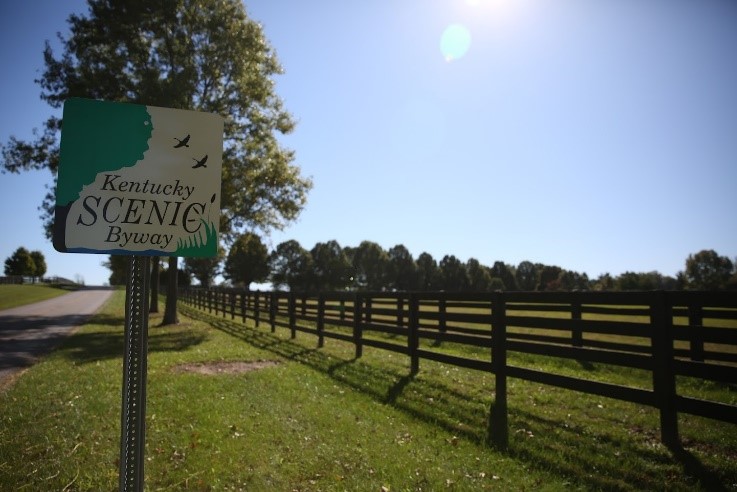
OLP performs some environmental work for its projects. The office works directly with the Kentucky Heritage Council to reach a concurrence that states any OLP project receiving federal funding complies with the National Historic Preservation Act of 1966 (NHPA). Section 106 of the NHPA requires federal agencies to consider the effect their activities may have on properties listed on or determined eligible for the National Register of Historic Places.
DOH typically lets and awards Rural Secondary Letting projects. On these projects, the department administers and inspects construction. Once awarded, projects are administered in the same manner as other DOH projects that are advertised and let through the Division of Construction Procurement. The only difference is that ORSR must be consulted on requests for additional funding and revisions to project limits. While uncommon, it is possible for DOH to administer portions of projects from the other programs listed above. When this occurs, DOH and DRMA must (1) closely coordinate with one another and (2) clearly define roles and expectations.


